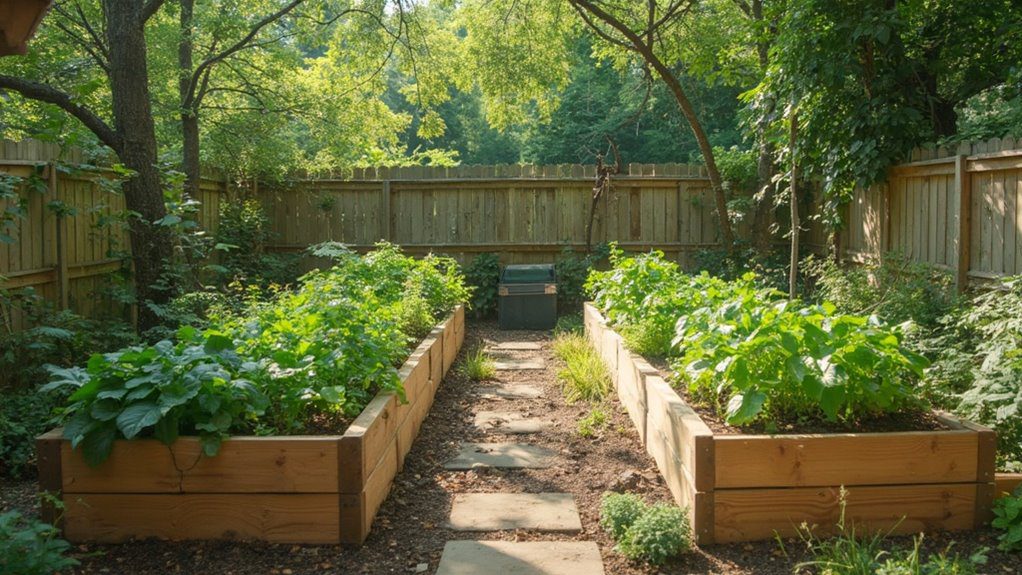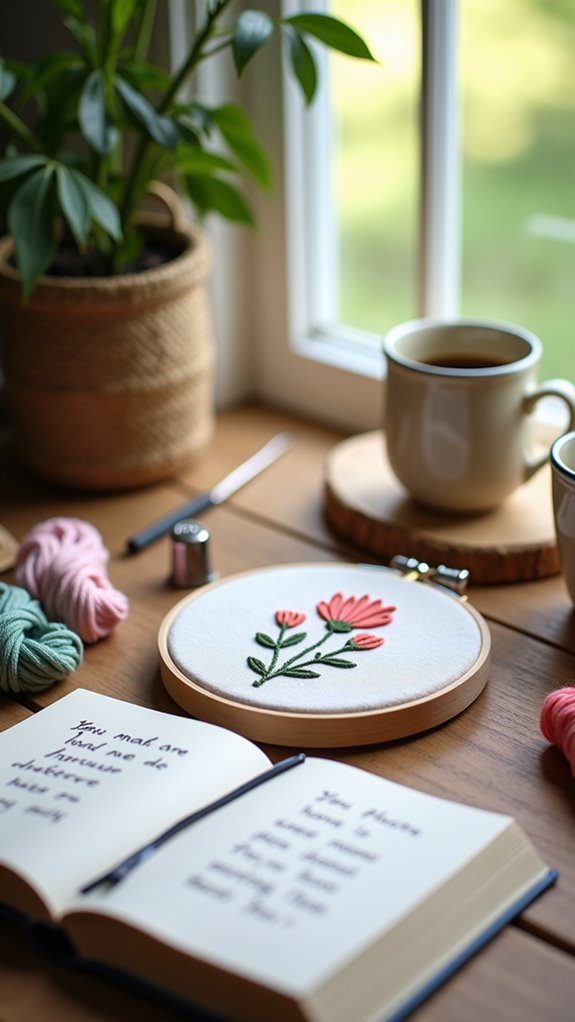We’re excited to share 25 easy DIY raised garden bed ideas that any beginner can tackle! Building raised beds not only enhances soil health but also makes gardening more accessible and enjoyable. We can use untreated cedar or even repurposed materials for creative designs. From tiered structures to unique shapes, there’s something for everyone. Join us as we explore these inspiring projects and uncover essential tips to make your gardening journey a success!
Key Takeaways
- Start with a simple rectangular design using untreated cedar boards for durability and ease of construction.
- Use essential tools like a tape measure, saw, and hand drill to build your raised beds accurately.
- Consider creative designs like tiered or circular beds to enhance visual appeal and accessibility.
- Implement pest control strategies, such as hardware cloth and companion planting, to protect your garden effectively.
- Engage with local gardening communities for support, resources, and sharing of gardening successes and ideas.
Benefits of Raised Garden Beds
When we think about diving into gardening, raised garden beds offer a world of benefits that can really transform our experience.
These elevated structures improve soil drainage and aeration, helping our plants thrive without the threat of waterlogging. They’re a game changer for accessibility, reducing strain on our backs and knees.
Plus, raised beds warm up faster in spring, giving us an early start to our gardening season. By minimizing soil compaction, we encourage deeper root growth, boosting plant health.
Finally, raised garden beds simplify weed and pest control, making our gardening journey more enjoyable and eco-friendly.
Essential Tools for Building Raised Beds
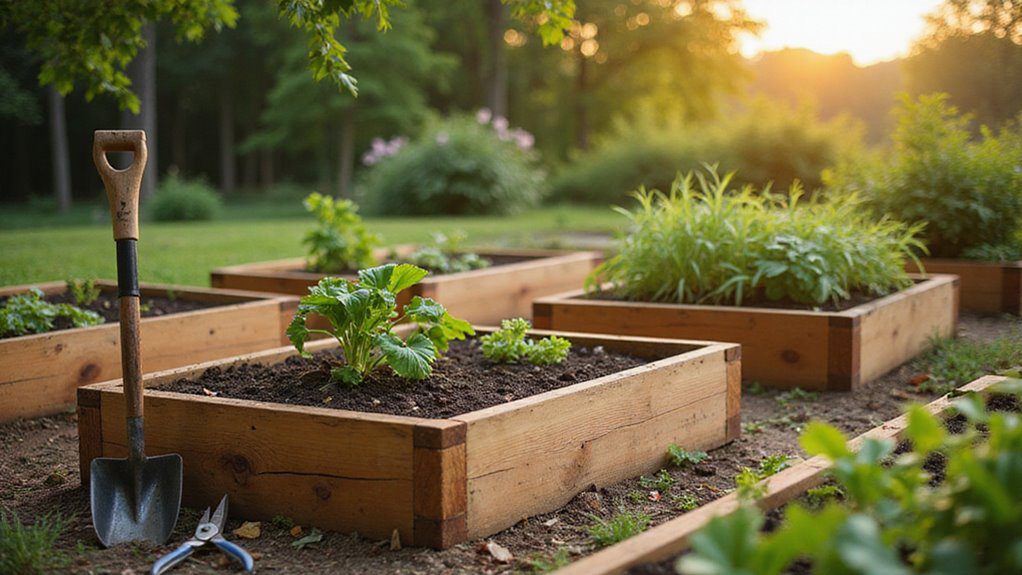
As we embrace the benefits of raised garden beds, it’s time to gather the tools that will bring our gardening dreams to life.
We’ll need a tape measure for precision, a pencil to mark our measurements, and a hand drill to assemble the frame. If we’re cutting lumber ourselves, a saw will be handy, but many stores offer pre-cut options.
Let’s not forget a 1/4 drill bit for pilot holes, a bolt tightener for sturdy construction, and safety gear like gloves and goggles.
Finally, we should find a level surface to guarantee our raised beds are built to last!
Materials Needed for DIY Raised Garden Beds
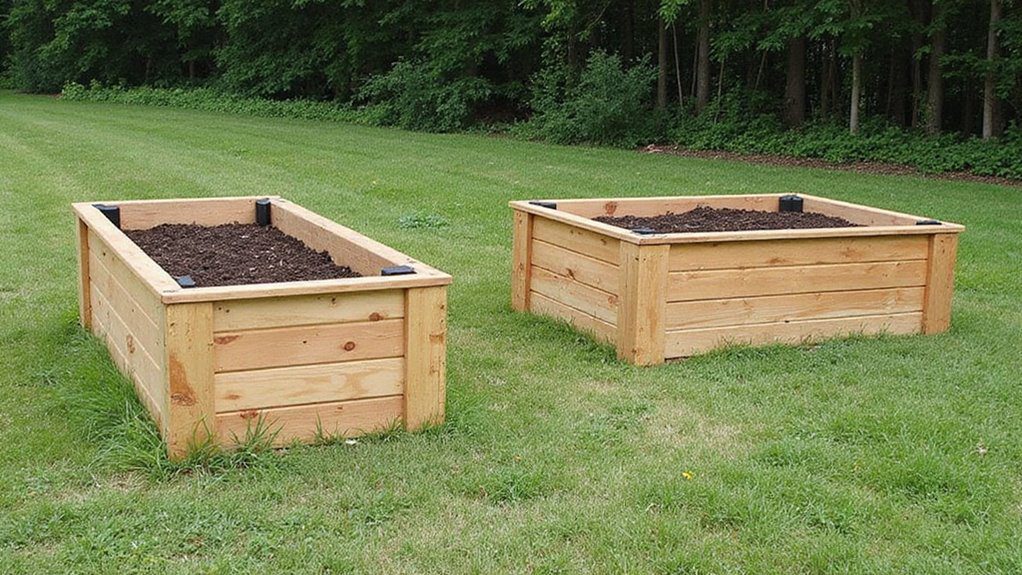
Creating our own DIY raised garden beds means we’ll need the right materials to guarantee they’re sturdy and effective.
We’ll start with untreated cedar boards, ideally 2 inches thick for durability. For a typical 4 x 4 bed, we’ll gather six 2 x 6 x 8 cedar boards, along with a 4 x 4 cedar board, cut into four 1-foot pieces, and a 3/4 x 4 board, also cut into four 1-foot sections.
Don’t forget galvanized wood screws, framing angles, and weed barrier cloth to enhance our soil health. With these materials, we’re set to build something truly special!
Choosing the Right Wood for Your Raised Bed
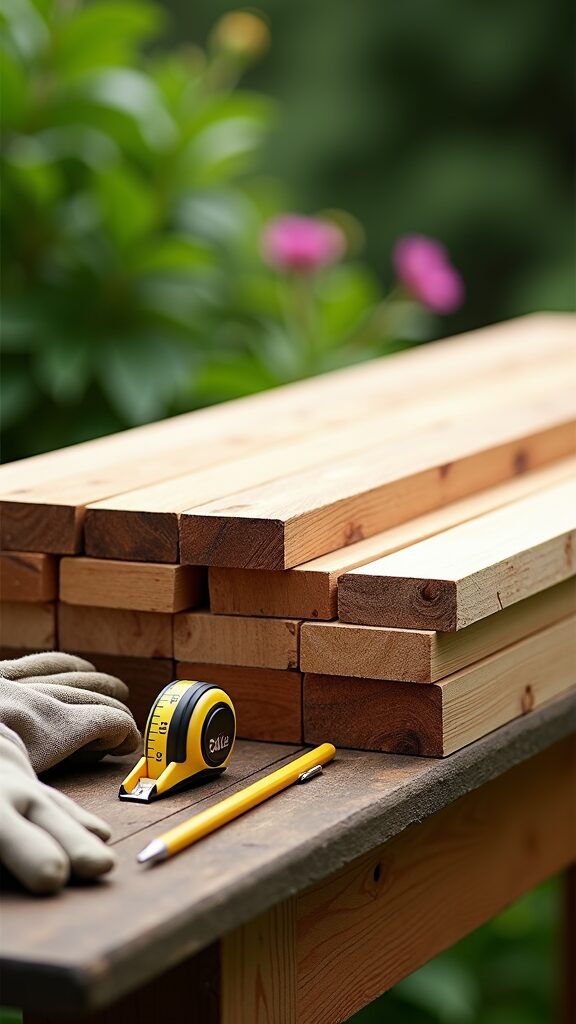
Now that we’ve gathered our materials for the DIY raised garden beds, the next step is to choose the right wood to guarantee our beds last and thrive.
We recommend untreated cedar for its natural resistance to rot and pests, while untreated pine offers a budget-friendly alternative without harmful chemicals.
Let’s steer clear of pressure-treated lumber with creosote—those chemicals can leach into our soil.
Opt for thicker boards, ideally 2 inches, for durability.
Inspect wood for straightness and damage before buying, and if we consider recycled materials, we’ll confirm they’re free from harmful treatments.
Happy building!
Step-by-Step Construction of a Raised Garden Bed
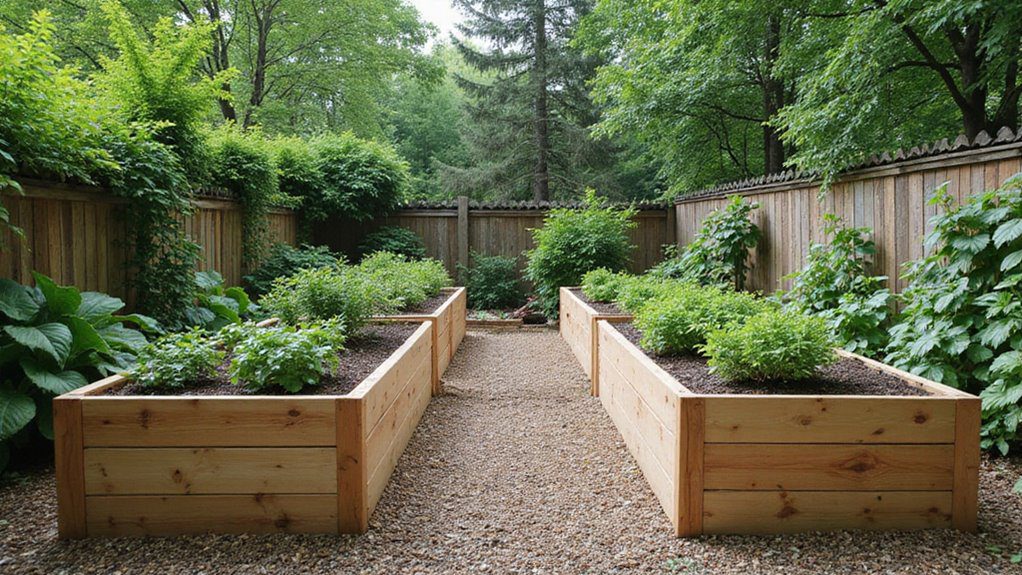
Once we’ve gathered our materials, building a raised garden bed becomes an exciting project that transforms our gardening aspirations into reality.
First, we select untreated cedar wood, cutting two 2×8 boards into four 4-foot lengths. Next, we assemble the frame by attaching end blocks to two boards, securing corners with 2.5-inch outdoor wood screws. Pre-drilling holes prevents wood from splitting, ensuring stability.
Lining the bottom with weed barrier cloth keeps pests at bay, while nutrient-rich soil offers our plants the best start. For added organization, we might even incorporate a grid or protective cage, enhancing our DIY raised bed experience.
Modifying Sizes for Your Raised Beds
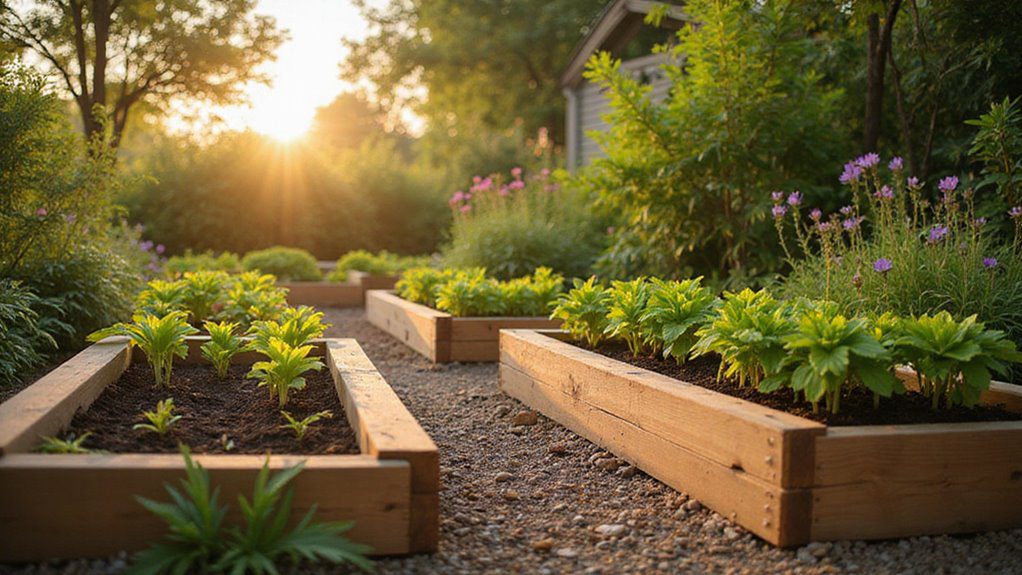
When we think about modifying the size of our raised garden beds, the possibilities are exciting and tailored to our gardening needs.
Here are some ideas to inspire our creativity:
- 4 x 4 x 6 for shallow-rooted plants like herbs and lettuces.
- 4 x 6 x 1 allows for diverse crop rotation and increased planting space.
- 4 x 8 x 1 maximizes our harvest with a wider range of plants.
- 2 x 6 x 1 suits limited spaces, perfect for herbs or small veggies.
Optional Features for Enhanced Raised Beds
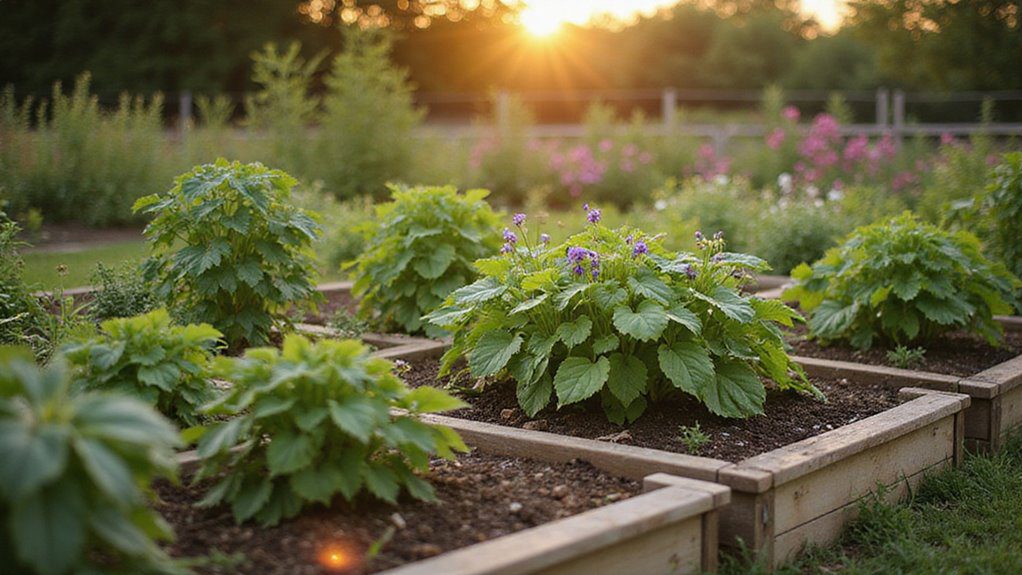
How can we take our raised garden beds to the next level? We can add two innovative features: a protective cage and a grid system.
By incorporating a protective cage around our plants, especially in wooded regions, we safeguard against pesky animals.
Meanwhile, creating a grid on top using PVC flat trim helps us organize plant spacing efficiently.
Let’s also consider adding chicken wire at the bottom to keep moles and voles at bay.
And don’t forget a layer of cardboard to suppress weeds!
These enhancements guarantee our raised beds aren’t just functional but thriving ecosystems.
Plant Selection for Your Raised Garden Bed
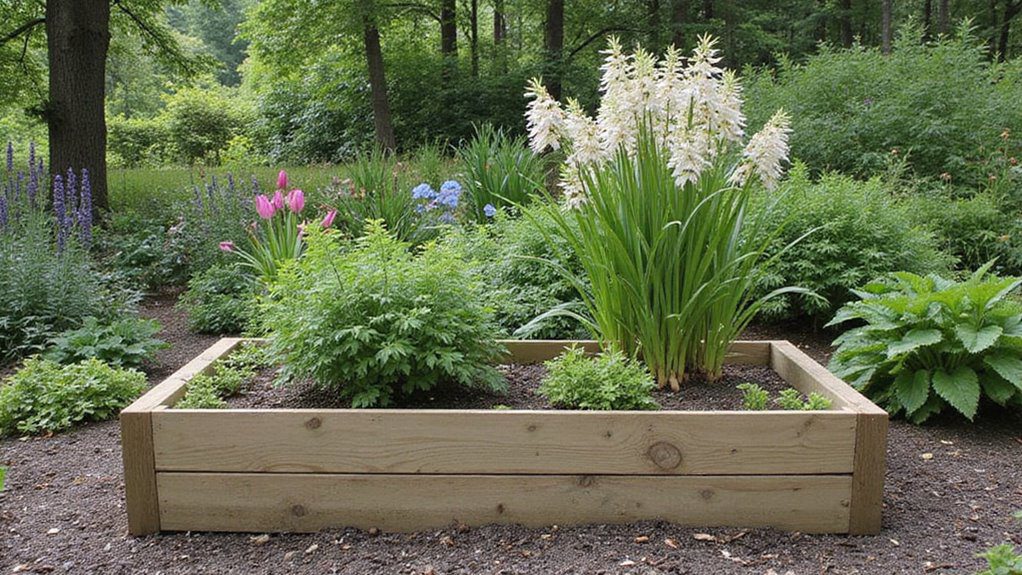
Choosing the right plants for our raised garden beds can make all the difference in creating a thriving green space.
Here’s how we can approach our plant selection for a vibrant vegetable garden:
- Root Depth: Opt for shallow-rooted plants like lettuce and herbs in 6-inch beds, while carrots and beets need at least 12 inches.
- Companion Planting: Pair tomatoes with basil for flavor and pest control, or plant strawberries with spinach.
- Sunlight Needs: Group plants by sunlight; full-sun varieties like tomatoes require 8 hours daily.
- Growth Habits: Use vertical supports for sprawling plants like cucumbers to maximize space.
Soil Preparation for Optimal Growth
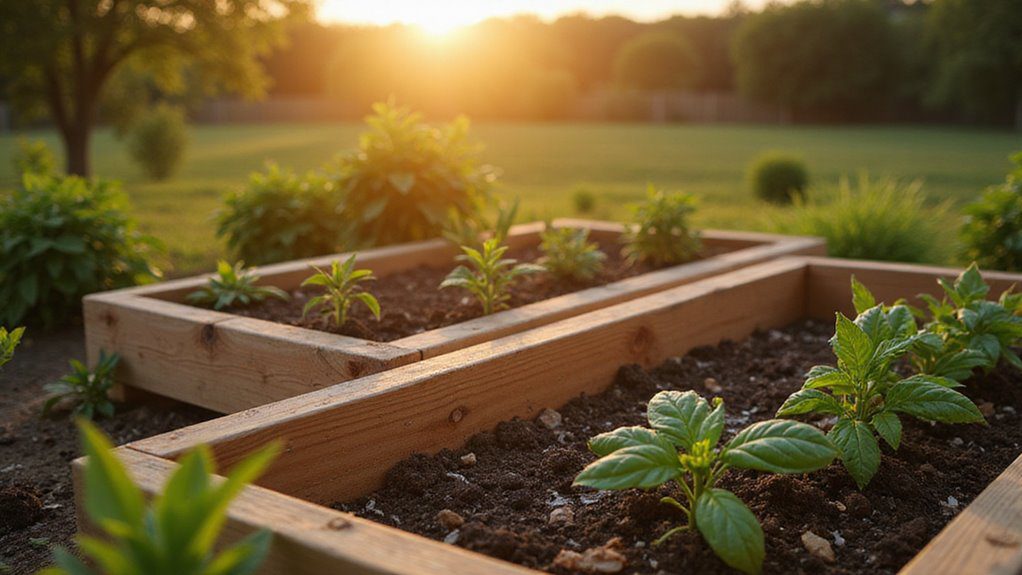
To guarantee our plants thrive in raised garden beds, we need to give careful attention to soil preparation.
Let’s mix nutrient-rich compost, quality garden soil, and organic matter for peak growth. A depth of 6-12 inches suits most plants, but deeper beds work wonders for root crops.
To supercharge soil fertility, we can incorporate organic materials like bat guano and worm castings. Plus, lining the bottom with a weed barrier cloth prevents unwanted plants while ensuring drainage.
Regular soil testing will help us monitor nutrient levels and pH, guiding amendments to create a thriving environment for our garden delights.
Watering Techniques for Raised Beds
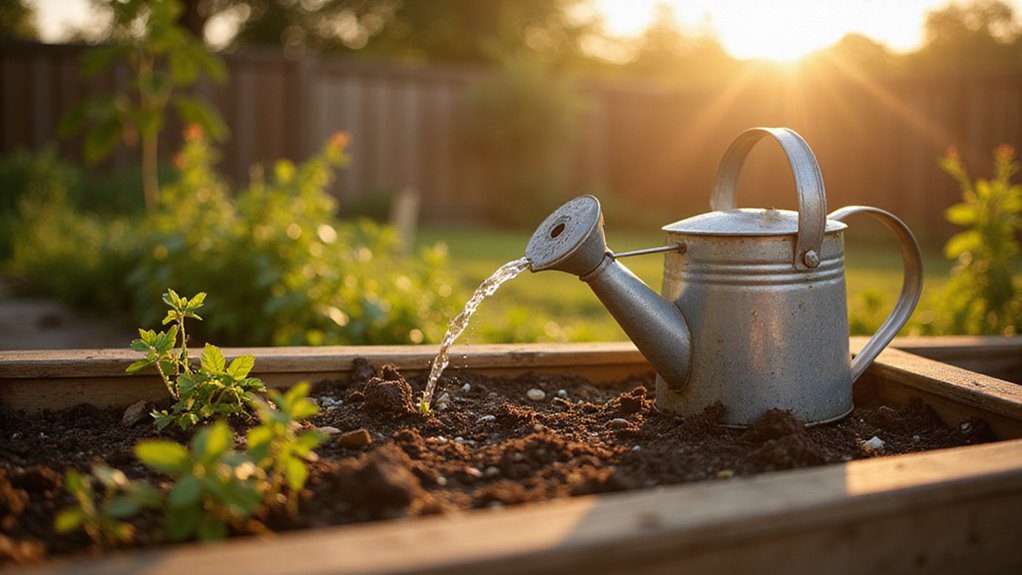
While watering might seem like a simple task, understanding the best techniques for our raised garden beds is essential for maximizing plant health.
Here are some innovative watering techniques to take into account:
- Water at the base of plants to reduce leaf wetness and prevent fungal diseases.
- Use a soaker hose or drip irrigation for efficient, direct root watering.
- Check soil dampness regularly; water when the top inch feels dry.
- Water deeply and less frequently, aiming for 1-2 inches per week.
Maintaining Your Raised Garden Beds
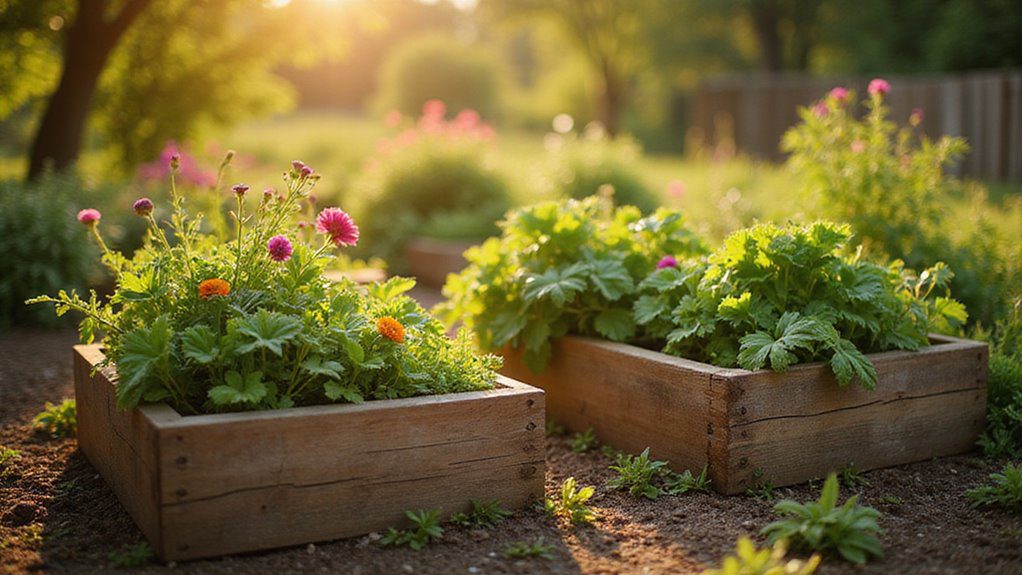
As we nurture our raised garden beds, consistent maintenance becomes essential for thriving plants and bountiful harvests.
We should regularly check soil moisture, watering at the base of our plants to promote deep root growth without over-saturation. Incorporating organic matter, like compost, each season enriches our soil, ensuring healthy plant growth.
Let’s monitor for weeds and pests weekly, promptly removing any intruders to keep our garden thriving. Rotating our crops seasonally prevents soil depletion and disease, while mulching with organic materials helps retain moisture and regulate temperature.
With these practices, our garden beds will flourish beautifully!
Pest Control Strategies for Raised Beds
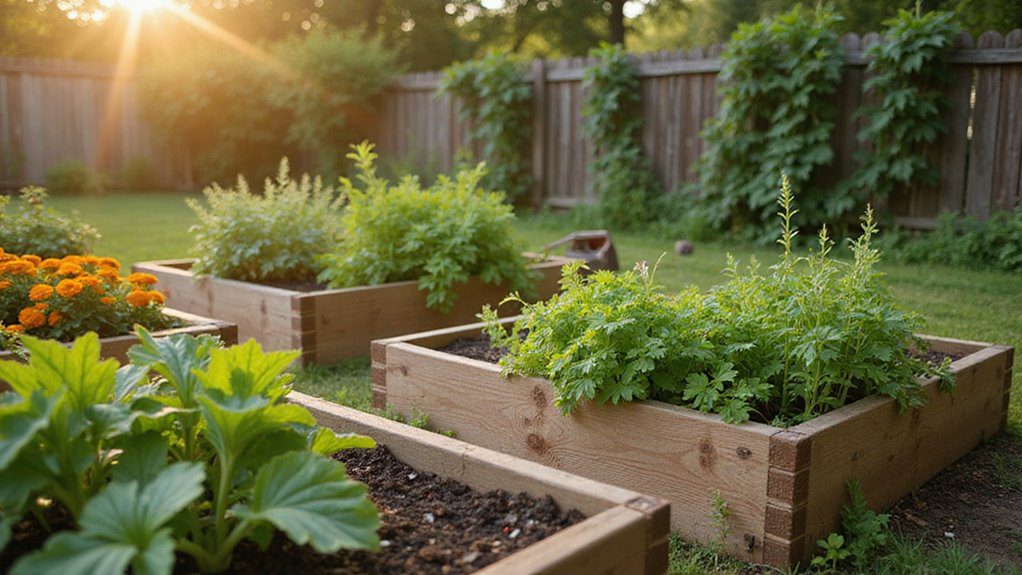
When we venture into the world of raised gardening, keeping our plants safe from pests is essential for a thriving harvest.
Here are some effective pest control strategies we can implement:
- Use hardware cloth at the bottom of raised beds to block underground pests like gophers.
- Install row covers or netting to deter aphids, cabbage worms, and birds.
- Embrace companion planting—adding marigolds wards off harmful insects while attracting pollinators.
- Regularly monitor for pests and remove infested plants or apply organic insecticidal soaps.
Creative Design Ideas for Raised Garden Beds
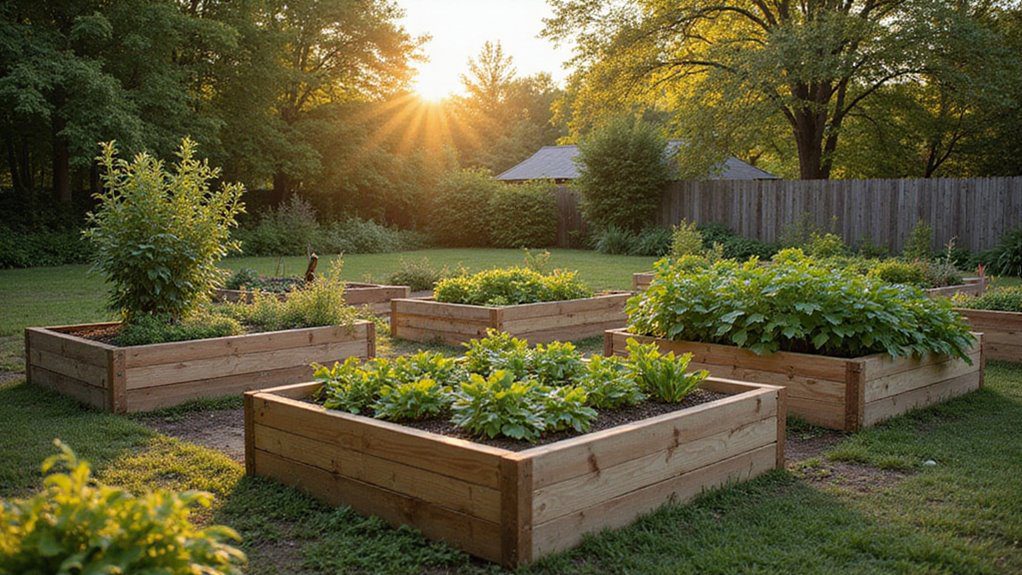
Whether we’re looking to add a touch of personality to our garden or maximize our growing potential, creative design ideas for raised garden beds can transform our outdoor space.
We can use untreated cedar or repurposed materials like fence pickets to create eco-friendly options.
Let’s experiment with tiered beds for visual interest and accessibility, and play with unique shapes like circular or zigzag designs.
Adding trellises or vertical systems allows us to support climbing plants while saving space.
Finally, painting our beds or incorporating decorative trims will enhance their aesthetic appeal, making our garden truly one-of-a-kind!
Using Recycled Materials for Budget-Friendly Beds
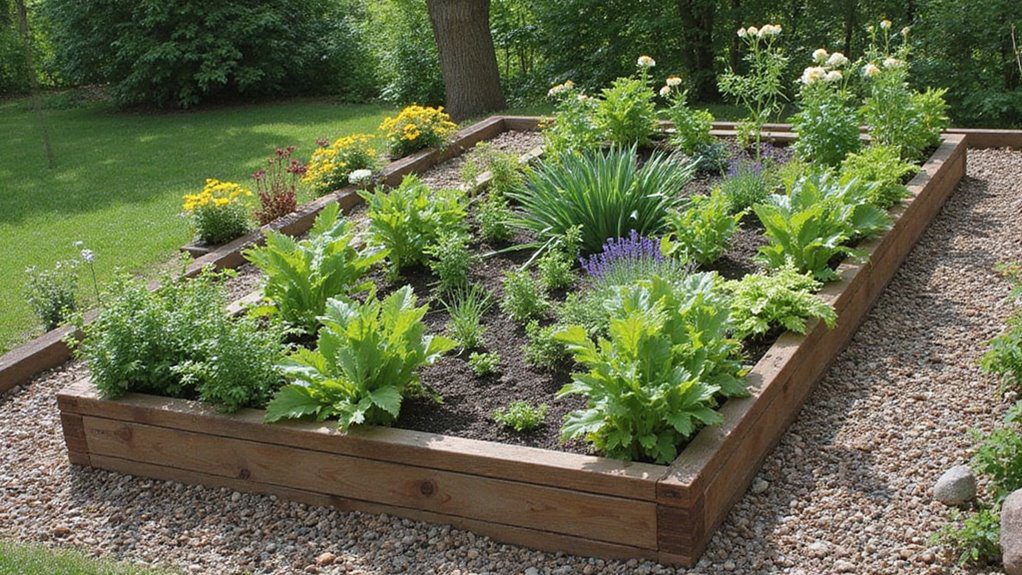
Exploring creative design ideas opens the door to even more possibilities when it comes to building our raised garden beds.
Using recycled materials not only saves money but also promotes sustainability. Here are some fantastic options for constructing inexpensive raised garden beds:
- Old wooden pallets—often free from local businesses.
- Reclaimed wood—ensures we avoid harmful chemicals.
- Cinder blocks—provide excellent drainage and aeration.
- Bricks from demolition sites—sturdy and visually appealing.
Vertical Gardening Techniques for Small Spaces
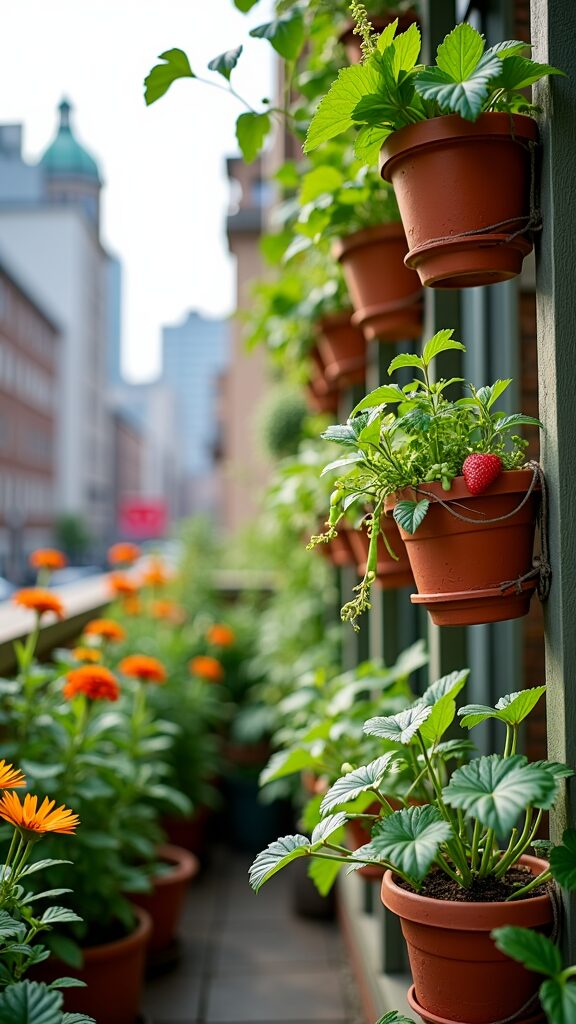
As we look to maximize our gardening potential in limited spaces, vertical gardening techniques offer a brilliant solution.
By utilizing trellises, wall planters, and hanging pots, we can grow plants upwards, making the most of our raised beds. This innovative approach not only enhances air circulation but also creates microclimates that protect our plants from harsh weather and pests.
Ideal candidates include climbing varieties like peas and cucumbers, along with flowering plants like strawberries.
Plus, vertical gardening can improve drainage and reduce soil compaction, increasing our yields by up to 30%.
Let’s elevate our gardening game!
Companion Planting in Raised Garden Beds
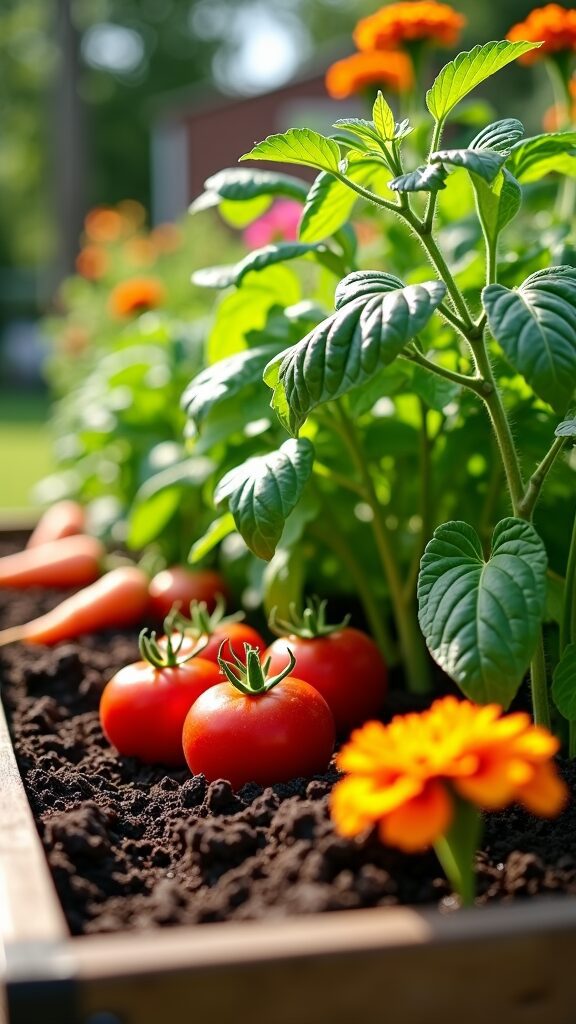
While vertical gardening techniques help us make the most of our limited spaces, companion planting in raised garden beds takes our gardening strategy to the next level.
By pairing compatible plants, we can enhance growth and deter pests. Here are four key benefits:
- Pest Control: Basil repels insects when planted with tomatoes.
- Space Maximization: Interplant radishes with carrots for efficient soil use.
- Ecosystem Balance: Marigolds attract pollinators and repel nematodes.
- Soil Health: Legumes like beans fix nitrogen, enriching neighboring plants.
Embracing companion planting transforms our raised garden beds into thriving ecosystems!
Seasonal Planting Guide for Raised Beds
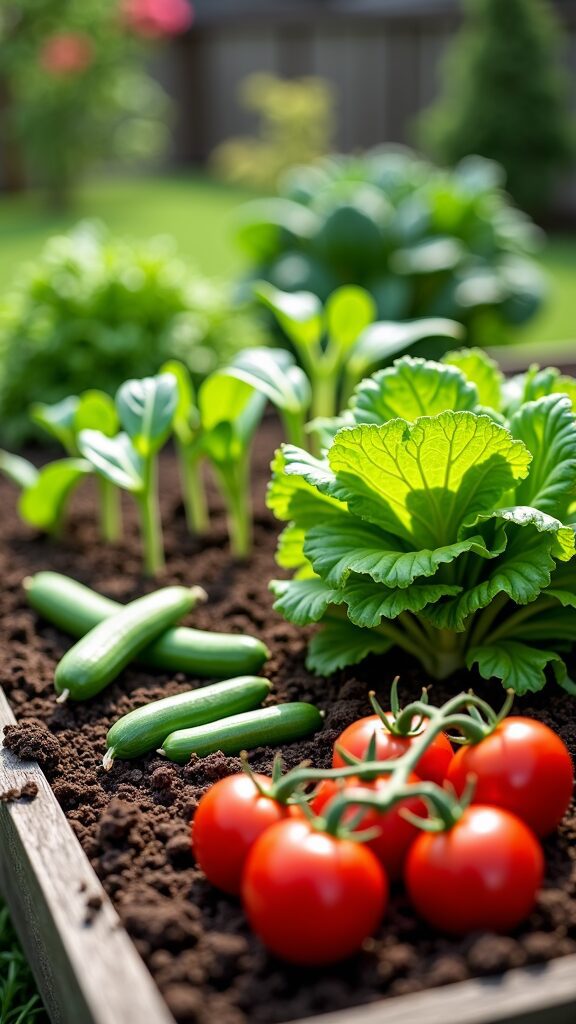
When we immerse ourselves in seasonal planting, we release the full potential of our raised garden beds.
In spring, let’s fill our beds with cool-season crops like lettuce and peas, savoring early harvests before summer’s heat.
As temperatures rise, we’ll shift to warm-season veggies such as tomatoes and cucumbers, thriving in that warm soil.
Come fall, we can plant garlic and shallots for a spring bounty.
Even winter’s chill won’t stop us; cold-hardy kale and carrots can flourish.
By embracing succession planting, we maximize our space, ensuring ongoing harvests throughout the seasons.
Let’s cultivate our creativity!
Enhancing Soil Health With Organic Matter
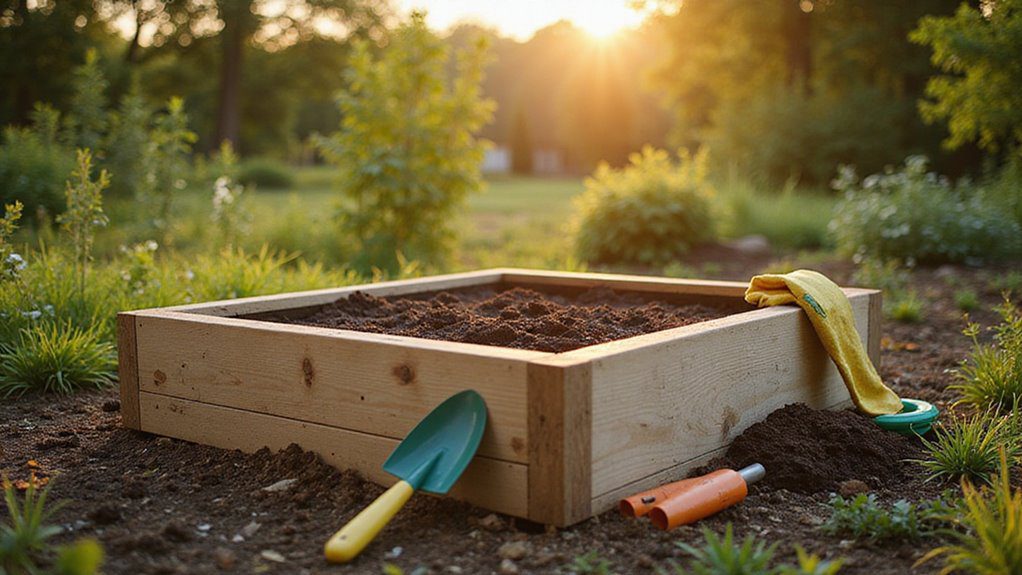
To enhance the health of our raised garden beds, we should embrace the power of organic matter. By incorporating it, we can transform our soil into a thriving ecosystem.
Here are four organic materials we can use:
- Compost – Enriches nutrients and improves fertility.
- Aged manure – Boosts soil structure and moisture retention.
- Leaf mold – Encourages beneficial microorganisms and earthworms.
- Kitchen scraps – Reduces waste while enhancing soil health.
Regularly adding these can elevate our garden’s liveliness, making nutrients more accessible to our plants.
Let’s create a rich environment that supports thriving gardens!
Using Covers and Cages for Protection
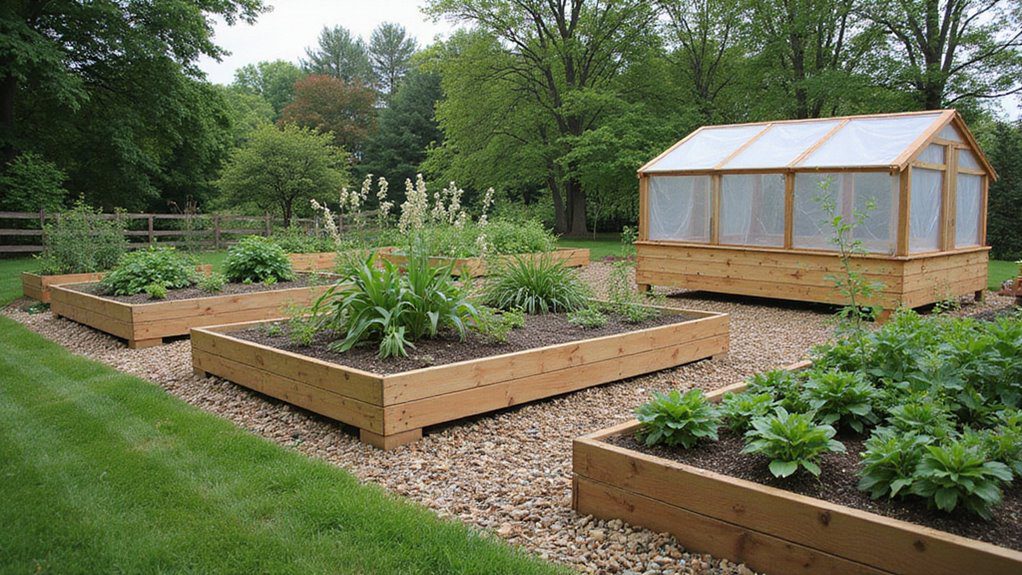
After enriching our raised garden beds with organic matter for ideal soil health, it’s time to think about protecting our plants from the elements and potential pests.
We can use covers, like row covers or fabric, to shield our plants from frost and harsh weather while still letting sunlight and moisture in. Cages made from chicken wire or PVC are fantastic for keeping larger animals like rabbits and deer at bay.
Winterizing Your Raised Garden Beds
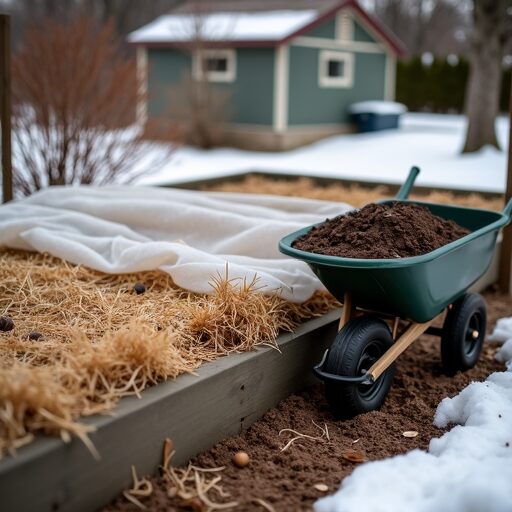
As winter approaches, we must take steps to protect our beloved raised garden beds from the harsh elements that can wreak havoc on our hard work.
Here’s how we can effectively winterize:
- Remove all dead plant material and weeds to prevent disease.
- Add a layer of mulch or straw for insulation and to protect beneficial microorganisms.
- Cover the beds with frost cloth or row covers, allowing sunlight and moisture in.
- Amend the soil with compost or well-rotted manure to enrich it for spring.
Common Mistakes to Avoid When Building Raised Beds
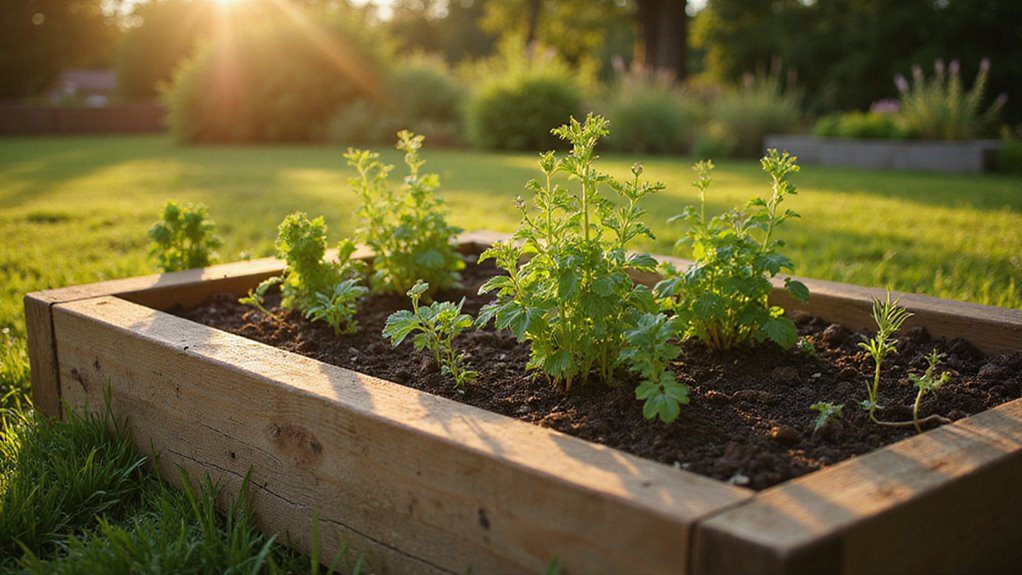
While building raised garden beds can be an exciting project, we often overlook common pitfalls that can undermine our gardening efforts. One major mistake is using chemically treated lumber, which can leach toxins into our raised bed with soil.
We should also guarantee proper drainage by lining the bottom with a weed barrier or hardware cloth to prevent root rot. Remember to choose a height of at least 6 inches for easy access and to select a sunny spot that gets 6-8 hours of light.
Finally, let’s not skimp on soil quality; a rich mix with compost is essential for thriving plants.
Engaging the Community in Your Gardening Journey
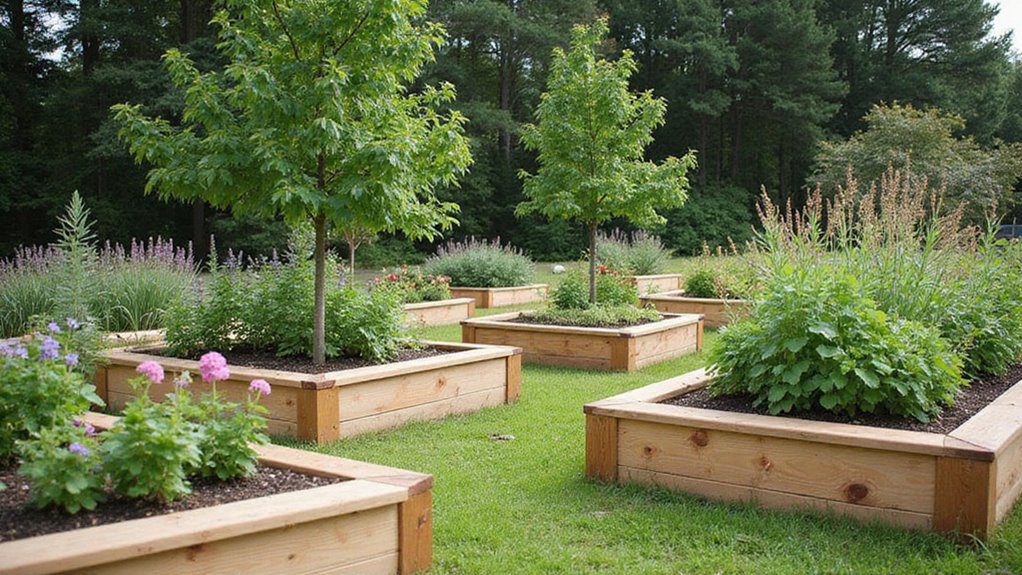
Engaging with our community can transform our gardening journey into a shared adventure, where we cultivate not just plants but friendships too.
For beginner gardeners, connecting with others can be invaluable. Here are some ways to get involved:
- Join local gardening clubs or online forums to share experiences and advice.
- Host events like seed swaps or planting days to foster collaboration.
- Utilize social media to document our progress and inspire others.
- Partner with schools or community centers for educational gardening projects.
Together, we can grow our gardens and our community, making every planting moment a celebration!
Resources for Further Gardening Knowledge
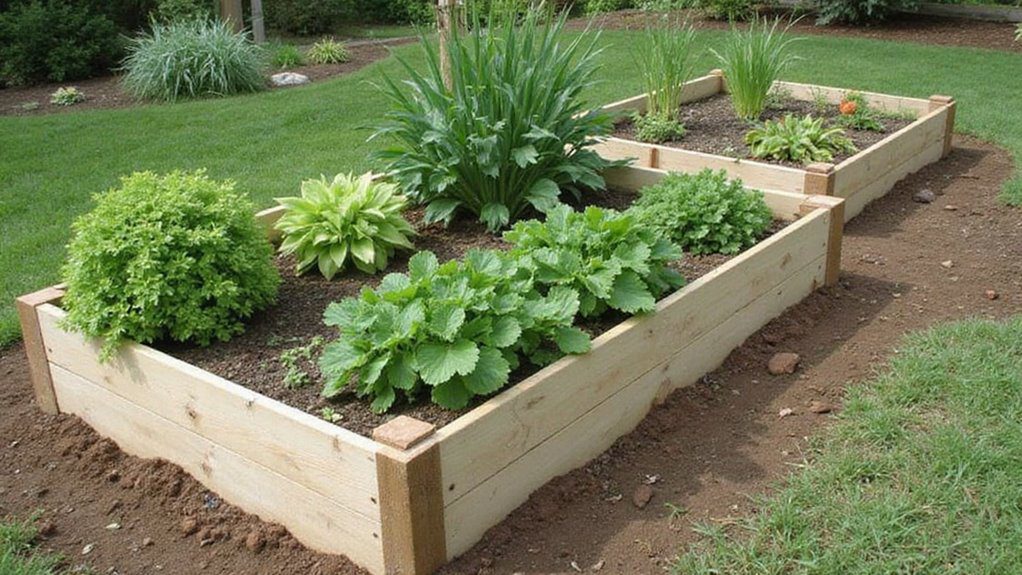
Whether we’re just starting out or looking to deepen our gardening knowledge, a wealth of resources is at our fingertips. Local gardening clubs and community gardens connect us with seasoned gardeners who share invaluable hands-on advice for our raised garden beds.
Online platforms like YouTube offer step-by-step guides that simplify construction, while expert blogs, like those of Nicole Burke, provide tailored tips and plant suggestions.
We can also explore workshops from local extension offices to enhance our understanding of soil health.
Finally, social media groups foster vibrant discussions, letting us ask questions and gain insights from fellow gardening enthusiasts.
Inspiring Stories From Successful Gardeners
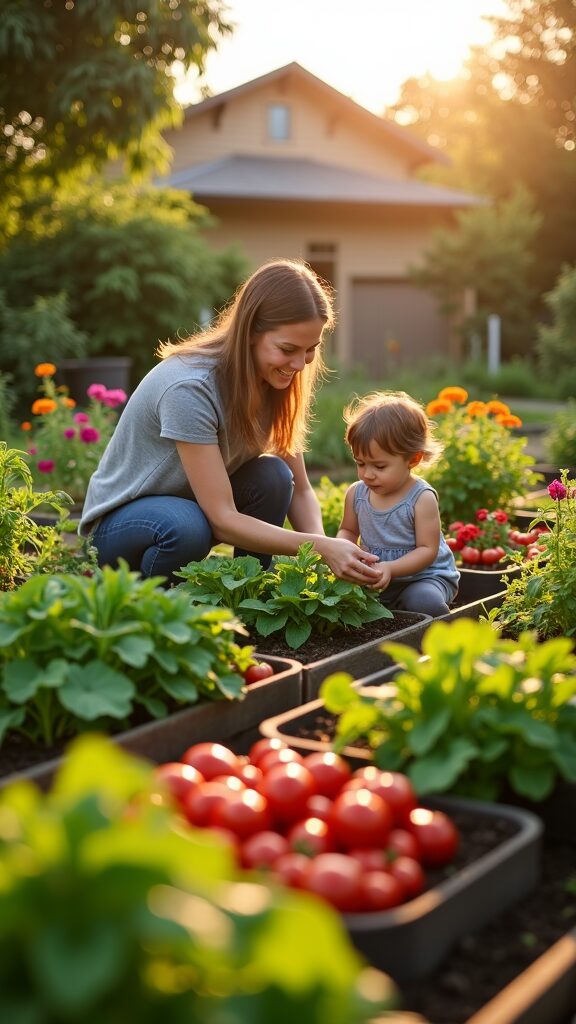
As we gather insights from experienced gardeners, we can’t help but feel inspired by their stories of triumph and growth.
Their journeys remind us that DIY work in the garden can lead to incredible experiences.
Here are some key takeaways:
- Creating family gardens nurtures self-reliance and pride in homegrown produce.
- Raised beds simplify planting and maintenance, allowing for diverse plant growth.
- Expanding garden space is a rewarding adventure, starting with just a few beds.
- Choosing the right materials and sourcing locally can elevate our gardening game.
Let’s embrace these stories and cultivate our own successes!
Celebrating Your Gardening Achievements
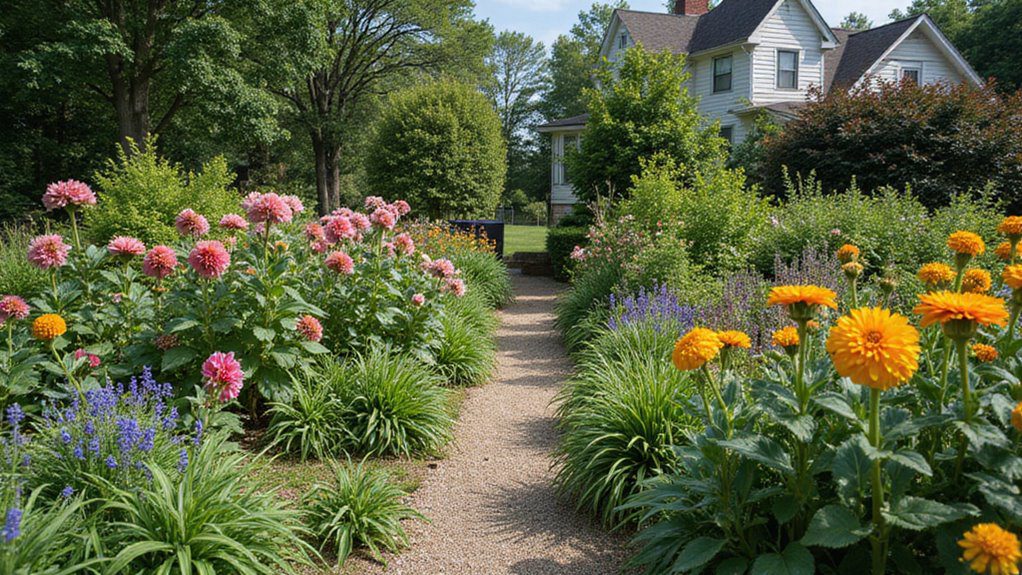
Celebrating our gardening achievements not only fuels our motivation but also deepens our connection with the natural world around us.
By documenting our progress through photos and journals, we can reflect on our growth and successes, creating a tangible record of our efforts.
Hosting a small gathering to share our harvest fosters community and pride in our labor.
Participating in local gardening competitions opens doors for recognition and learning from fellow enthusiasts.
Plus, sharing our achievements on social media inspires others, forming a supportive network where we all celebrate our gardening journeys together.
Let’s embrace these moments and thrive!


